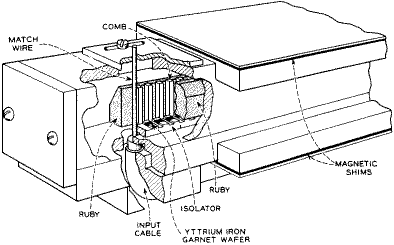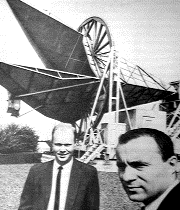MICROWAVE LASER USED TO DISCOVER COSMIC BACKGROUND RADIATION

Microwave laser (Tabor and Sibilia, 1963) used by Penzias and Wilson (1965)
to discover the 3 Kelvin microwave black body cosmic background radiation.
Quantum Description
A couple of years after the first successful construction of the gas microwave
laser,
Bloembergen
(1956) suggested an alternative approach with paramagnetic
materials by using three levels instead of two.
The solid state microwave ruby laser is based on
power saturation
of the
first and third levels of a three level paramagnetic ion (triply ionized chromium)
by the use of strong pumping radiation. The populations of level 1 and 3 tend to
become equal in these circumstances, thus establishing a population inversion
between level 3 and 2.
The very small energy separations typical of microwave laser transitions
requires that the crystal be cooled to cryogenic temperatures to reduce the
thermal contributions to the excited states, especially the lower
laser level, thus allowing for rapid radiative de-population of level 2.
Low temperatures are also required in order to reduce non-radiative processes
such as phonon collisions (lattice vibrations) which compete with the radiative
processes and can reduce the lifetime of the upper laser level 3
( it must have a longer lifetime than that of the lower laser level, if the decay
or relaxation rate of level 2 to 1 is more rapid than the decay from level 3 to 2
then continuous operation is possible ).
Mechanical Description
Since the microwave laser was to be used as an amplifier and not as an
oscillator, potential feedback caused by impedance mismatching at various
frequencies was eliminated by using a travelling-wave approach which afforded
high gain in one direction and little or no gain in the reverse direction.
It consisted (Tabor and Sibilia, 1963) of a slow-wave structure built of a
conductive comb sandwiched by a pair of ruby crystals all contained
within a dual mode waveguide cavity. The cavity must transmit the pump power while
simultaneously allowing the signal frequency to pass as well. The population
inversion is pumped
by a microwave klystron whose frequency closely matches the resonant frequency
of the chromium transition from level 1 to level 3.
The ruby is cooked by a microwave oven while simultaneously
being chilled by liquid helium at 4.2 degrees Kelvin from absolute zero.
Microwave energy falling within the bandpass is exponentially amplified as a
function of distance traveled through the active medium up to a factor of
10,000 or more. Its noise temperature was too low to be measured and operated at 4.17 GHz but
could be tuned by varying the strength of the external magnetic field.
NOTE:The modern incarnation of this type of laser is the
fiber optic laser amplifier.
Practical Use
This very-precise microwave laser preamplifier was used by
Arno Penzias and
Robert Wilson
(1965) for astronomical research but was originally built by
Bell Laboratories for the Telstar satellite communication experiments.
After having eliminated all possible sources of noise ( including pigeon
droppings they nicknamed white-dielectric !) they discovered the
3 Kelvin black body
cosmic background radiation.
They later won the 1978 Nobel Prize in Physics for this discovery.
 Penzias (right) and Wilson (left) near the horn antenna used to make their
discovery (Courtesy of AT&T archives)
Penzias (right) and Wilson (left) near the horn antenna used to make their
discovery (Courtesy of AT&T archives)
The
ruby microwave laser
is still in use in the
NASA Deep Space Network
and as a compact amplifier aboard
spacecraft.
VLBI
Very high resolution
radio images
of laser stars (quasars) rely on the
hydrogen microwave laser
as an
ultra precise clock
to synchronize data measured by widely separated radio antennae of a
VLBI network (Very Long Baseline Interferometry).
REFERENCES
- Bloembergen,N.: 1956, Phys.Rev., 104, 324.
- Penzias,A.A., Wilson,R.W.: 1965, Astrophys.J., 142, 419, 1149.
- Tabor,W.J., Sibilia,J.T.: 1963, Bell Syst.Tech.J., 42, 1863.
- Wilson,R.W.: 1990, in Modern Cosmology in Retrospect, eds.
Bertotto,B. et al., Cambridge Univ. Press.
- COsmic Background Explorer WWW ( COBE )
- The Cosmic Microwave Background Radiation
- VLBI; Very Long Baseline Interferometry
 "Philosophically, I liked the steady-state cosmology. So I thought that
we should report our results as a simple measurement; the measurement might be
true after the cosmology was no longer true !"
"Philosophically, I liked the steady-state cosmology. So I thought that
we should report our results as a simple measurement; the measurement might be
true after the cosmology was no longer true !"
-R.W. Wilson (1990)
Laser History
 Penzias (right) and Wilson (left) near the horn antenna used to make their
discovery (Courtesy of AT&T archives)
Penzias (right) and Wilson (left) near the horn antenna used to make their
discovery (Courtesy of AT&T archives)
 Penzias (right) and Wilson (left) near the horn antenna used to make their
discovery (Courtesy of AT&T archives)
Penzias (right) and Wilson (left) near the horn antenna used to make their
discovery (Courtesy of AT&T archives) "Philosophically, I liked the steady-state cosmology. So I thought that
we should report our results as a simple measurement; the measurement might be
true after the cosmology was no longer true !"
"Philosophically, I liked the steady-state cosmology. So I thought that
we should report our results as a simple measurement; the measurement might be
true after the cosmology was no longer true !"